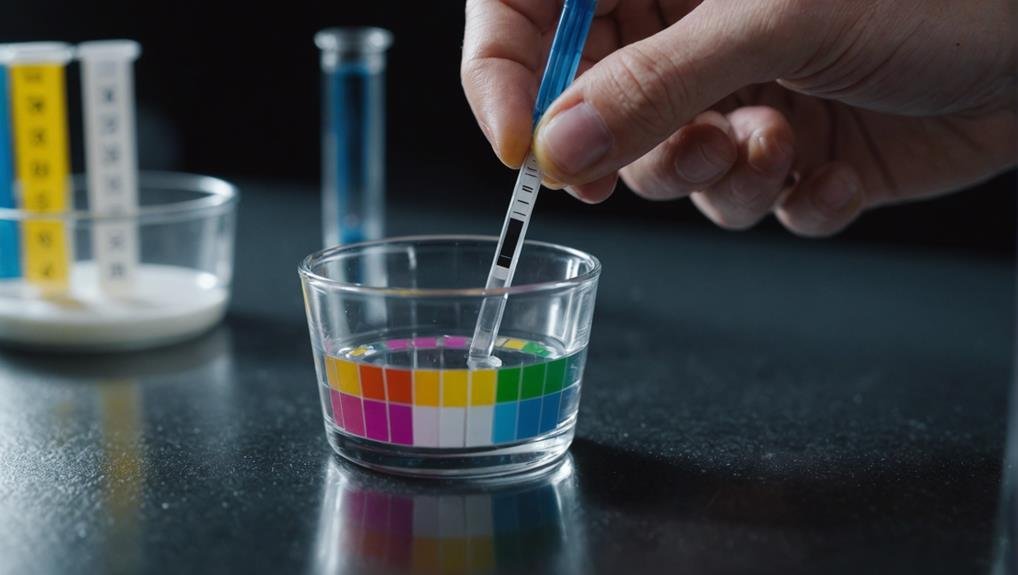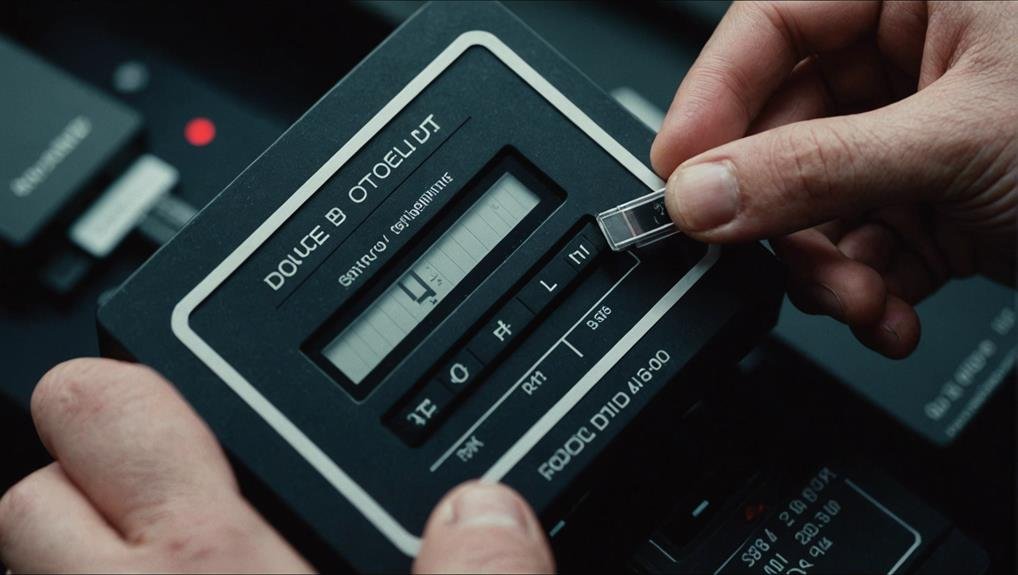To begin, make sure to select the correct test strips that are not expired and are suitable for your equipment.
Set up a clean, well-lit workspace with all the necessary materials at hand.
Collect a water sample using a clean container from the appropriate depth and mix it thoroughly.
Carefully insert the test strip into the sample and wait as instructed.
Once the results appear, compare the color changes to the provided chart to determine the readings.
If the results seem inaccurate, troubleshoot by checking for expired strips or mishandling.
By following these steps carefully, you can ensure accurate and reliable results from your test strips.
Choosing the Right Test Strips
When choosing the right test strips, it's crucial to consider the specific parameters you need to test. For instance, if you're checking pool water chemistry, look for strips that measure pH, chlorine, and alkalinity. If you're monitoring glucose levels, opt for strips designed for that purpose. Make sure the test strips are compatible with your testing equipment to ensure accurate results.
Always check the expiration date before purchasing test strips, as using expired ones can lead to unreliable readings. Compare costs and quantities to find the best value without compromising quality. Reliability and accuracy are key, so read reviews or consult professionals to identify trustworthy test strip brands. It's essential to be confident in the precision of the results you're getting.
Preparing the Test Area
Let's ensure our testing area is set up correctly for accurate results with the chosen test strips. Start by selecting a well-lit spot as good lighting is crucial for clear observation of color changes or indicators on the test strip. Additionally, make sure the area is dry as moisture can disrupt the test results.
Cleaning the testing area is essential to prevent any contamination that could affect the accuracy of the readings. Once the area is clean, gather all the necessary materials including the test strips, any tools needed for sample collection, and a timer if required for monitoring development time.
Choose a flat and stable surface to work on to prevent any spills or disruptions that could impact the test outcome. Before starting, review the specific instructions provided with the test strips to ensure proper usage and accurate interpretation of the results. Familiarizing yourself with these details is crucial for a successful test.
Collecting a Sample

When collecting a water sample, it's crucial to use a clean container to prevent contaminants from affecting the test results. Starting with a debris-free container is essential to ensure the accuracy of the outcome.
The water sample should be taken from the appropriate depth, submerging the container to a level where the water is well-mixed to avoid surface contaminants like leaves or oils.
It's important to follow the specific instructions provided with the test strips for accurate testing. These guidelines typically specify the correct depth, often around elbow-deep, to gather a representative sample.
Care should be taken not to introduce any debris during the collection process, as even small particles can impact the test results.
Collecting a sufficient amount of water is also crucial. Fill the container to the recommended level to ensure there's enough water for the test strips to interact with.
Mixing the Sample With Water
After collecting a clean water sample, it's crucial to mix it properly with the test substance for accurate results. First, place the drug residue in a clean container to prevent any potential contaminants from affecting the test. Adding water to the container and mixing the sample thoroughly helps dissolve any drug residue, making it easier for the test strips to detect substances like fentanyl.
Once the sample is well-mixed, insert the test strip into the water mixture and let it sit for 15 seconds to absorb the sample correctly. After removing the test strip, wait for 5 minutes to check the results. A single red line on the test strip indicates the presence of fentanyl, signaling a high risk, while two red lines mean no fentanyl is detected. If no red lines appear, the test is invalid, and a retest with a new sample and test strip is necessary.
Inserting the Test Strip

Ensuring the test strip is fully and securely inserted into the designated slot is crucial for accurate readings. It's essential to pay close attention to the insertion process as it directly impacts the reliability of the results.
When inserting the test strip, push it all the way into the slot until it reaches its limit. This secure placement helps prevent errors and ensures the device can read the strip correctly.
Always refer to the user manual for specific guidance on inserting the test strip. Each device may have slight variations in the slot design, so following the manual can prevent mistakes. Incorrect insertion could lead to inaccurate readings, compromising result reliability.
Before proceeding with the test, double-check that the test strip is properly aligned and fully inserted. Failure to insert the strip correctly may cause the device to malfunction, resulting in unreliable readings. By ensuring a secure insertion, you can trust the accuracy of the results.
Waiting for Results
Once the test strip is securely inserted, it's crucial to wait patiently for the results to fully develop. The waiting time varies depending on the specific test, ranging from seconds to minutes. Following the instructions provided with the test strips is essential to ensure accurate results. Each test has a specified waiting time that must be followed diligently to prevent misinterpretation and inaccurate readings.
The waiting period allows for the chemical reactions on the test strip to occur correctly, enabling an accurate interpretation of the results. It's important to resist the temptation to check the results early to avoid any potential misreadings. Some tests may display results almost immediately, while others might take a few minutes. Patience during this waiting period is key to obtaining reliable results.
For instance, pregnancy tests usually require a few minutes for the results to show up clearly. On the other hand, blood glucose tests might provide immediate results. By allowing the necessary waiting time for each specific test, we can ensure the accuracy of the outcome.
Interpreting the Lines

Understanding the lines on a fentanyl test strip is crucial for interpreting results accurately and making informed decisions. These lines convey vital information that can help prevent overdoses and promote safety.
When a single red line appears on the test strip, it indicates the presence of fentanyl in the substance being tested. This signal warns of a high risk of overdose, emphasizing the need for extreme caution.
Conversely, if two red lines are visible, it signifies that no fentanyl is detected, reassuring that the substance is free from this potent opioid.
However, an absence of red lines on the test strip renders the result invalid. This outcome signals a testing error, necessitating a retest for reliable results. Ensuring the accuracy of test outcomes is paramount in making well-informed decisions to safeguard against harm.
Mastering the skill of interpreting fentanyl test strip results is a key component of harm reduction and overdose prevention. Whether confirming the presence or absence of fentanyl, accurately reading and understanding the test strip lines is pivotal in promoting safety and minimizing risk.
Troubleshooting Invalid Results
When facing invalid results with a fentanyl test strip, it is crucial to troubleshoot for accurate readings. Often, improper testing techniques or contamination can lead to these issues. It is essential to carefully follow the instructions and maintain a clean testing environment.
Contamination may arise when the sample used for testing is impure, resulting in inaccurate results. In such cases, consider using a clean sample or conducting a retest. If invalid results persist, seeking guidance from harm reduction organizations can be beneficial.
Proper storage and handling of fentanyl test strips are vital to prevent invalid readings. Ensure to store the strips in a cool, dry place away from direct sunlight to preserve their effectiveness.
Here is a summary of common issues and their solutions:
| Issue | Potential Cause | Solution |
|---|---|---|
| Invalid result | Improper testing technique | Follow instructions carefully |
| Contaminated sample | Contamination | Use a clean sample, retest if necessary |
| Consistent invalid results | Repeated errors | Consult harm reduction organizations |
| Test strip degradation | Poor storing/handling | Store properly in a cool, dry place |
Conclusion
We stumbled upon the importance of selecting the right test strips and accurately interpreting the lines by chance. It turns out that these factors play a significant role in the accuracy of our results.
To ensure reliable readings, it's crucial to properly prepare the test area, collect the sample correctly, and diligently follow each step of the process. If any issues arise, troubleshooting can help us effectively resolve them.
By following these steps, we can confidently rely on test strips to provide accurate readings, allowing us to make informed decisions in our testing procedures.

